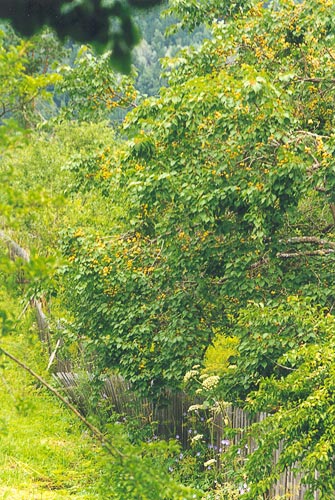Relatives
Armeniaca mandshurica (Maxim.) Skvorts. - Manchurian apricot.
Taxonomic position.
Family Rosaceae Juss. genus Armeniaca Scop.Synonyms.
Prunus armeniaca L. var. mandshurica Maxim., Prunus mandshurica KoehneMorphology and biology.
The tree is 8-10(15) m tall. Its trunk is up to 45 cm in diameter, covered with soft and deeply rimose dark-gray bark. It has 6-8 leaves; 2.5-5 cm long (on fructiferous branches up to 15 cm in length and 8 cm in width), ovate, elliptic, with a gradually attenuate sharp tip, rounded at the base, grossly serrate or roughly bidentate, naked on both sides or weakly pubescent from below. Flowers are light-pink or almost white, up to 2.5 cm in diameter. Pedicels are naked, rather long (7-12 mm), longer than the tube of the calyx. Fruits are 1.5-2.6 cm in diameter, roundish or oval, downy, yellow, sometimes with red tan or mottle, often rather juicy, with bitter or sour pulp, non-dehiscent. Kernels are 13-18 mm long, with an obtuse rib of the ventral suture and foveolate surface. The nucleus is sweet. Entomophilous. Ornitochore. Characterized by rapid growth. Reproduces by seeds and summer cuttings. Seed needs to be stratified for 3 months at 1-5 degrees Centigrade. Blossoms in May; bears fruit in August/early September.Distribution.
Maritime Territory of Russia (Southern Ussuri region), north-eastern China, and North Korea. The area forms a narrow band from north to south - from Khanka Lake and Southern Ussuri across Eastern Manchuria to the forests of North Korea.Ecology.
Xerophyte. Photophilous. Grows on dry stony mountainsides in small clusters or as solitary trees, often within oak groves and brushwood.Utilization and economic value.
Used for food (fruit). Local populations would use the fruit to make candy, pastila, jam and filling for sweets. It is a valuable source of hardy, frost-resistant stock used for cultivated apricots. The species is promising for breeding commercially valuable cultivars. It was one of the parents of I.V. Michurin's varieties that demonstrated hardiness during the winter seasons in the central regions of Russia. It can be hybridized with the plum varieties because it possesses the highest degree of frost-resistance.Reference citations:
Brezhnev D.D., Korovina O.N. 1981. Wild relatives of cultivated plants in the flora of the USSR. Leningrad: Kolos. 375 p. (In Russian)Kharkevich S.S., ed. 1996. Vascular plants of the Soviet Far East. Leningrad: Nauka. V. 8: 244-245. (In Russian)
Koropachinskiy I.Yu., Vstovskaya T.N. 2002. Woody plants of the Asian part of Russia. Novosibirsk: Publishing House of SB RAS, Branch "Geo". 298-299 pp. (In Russian)


